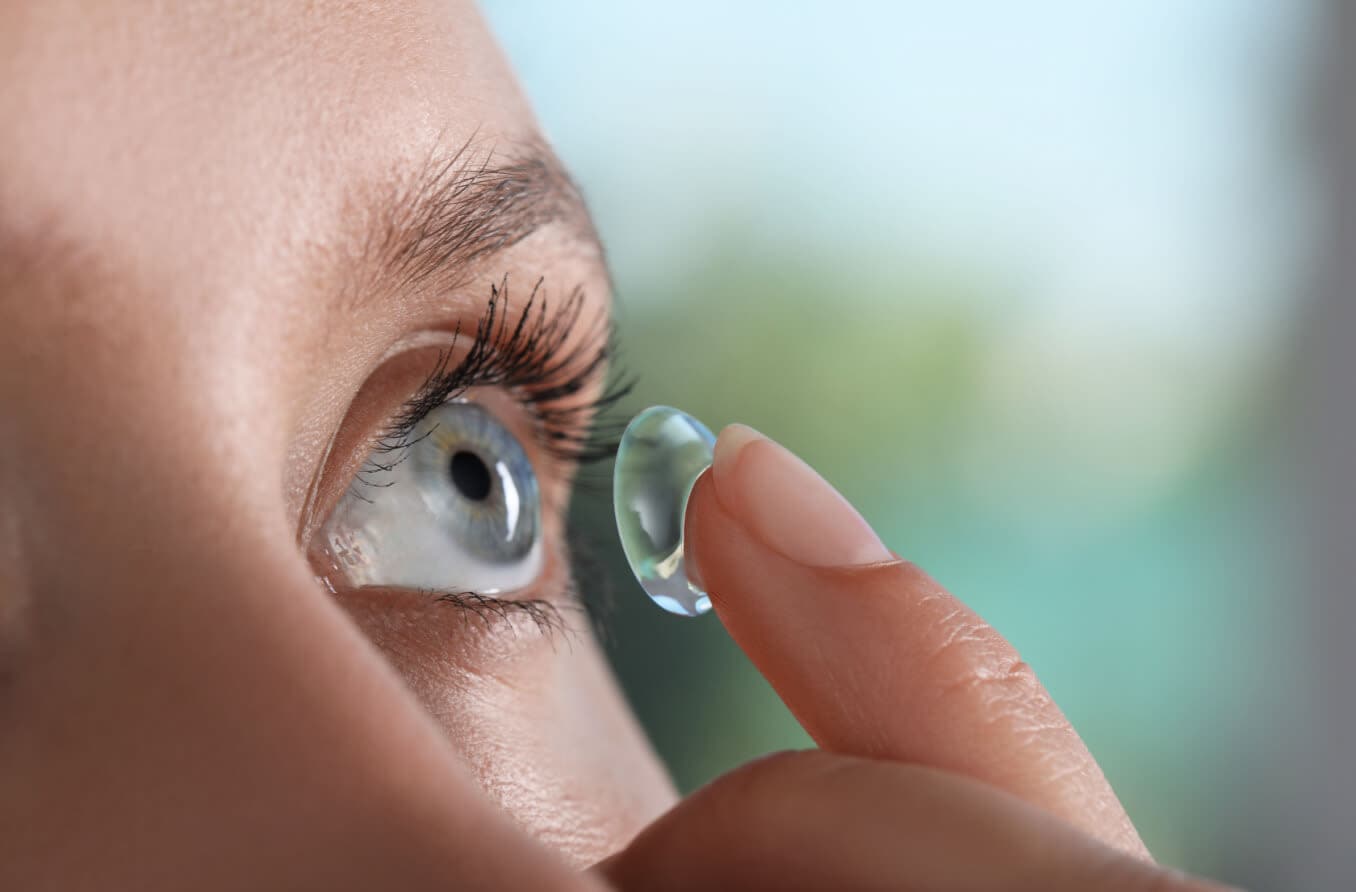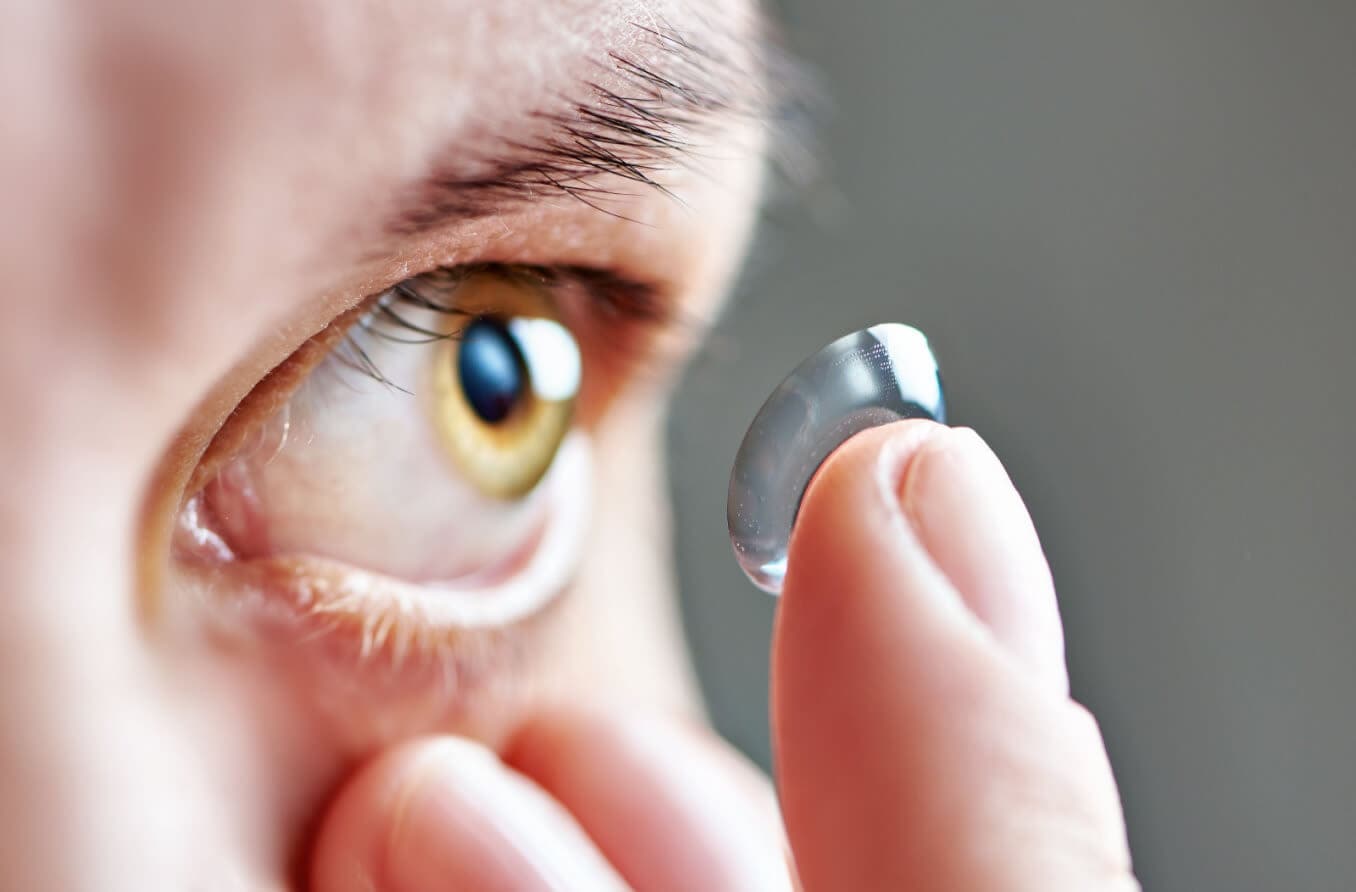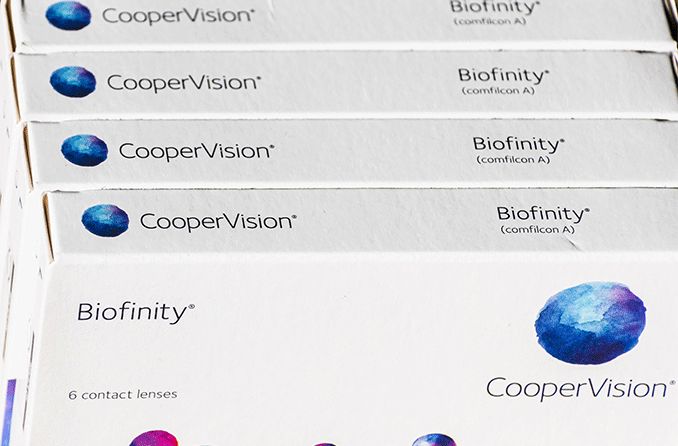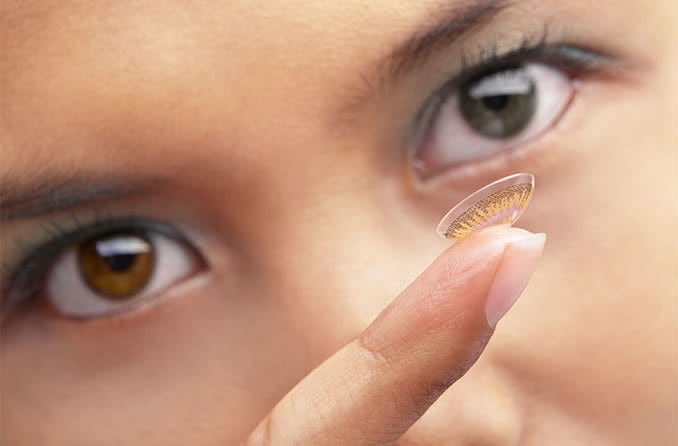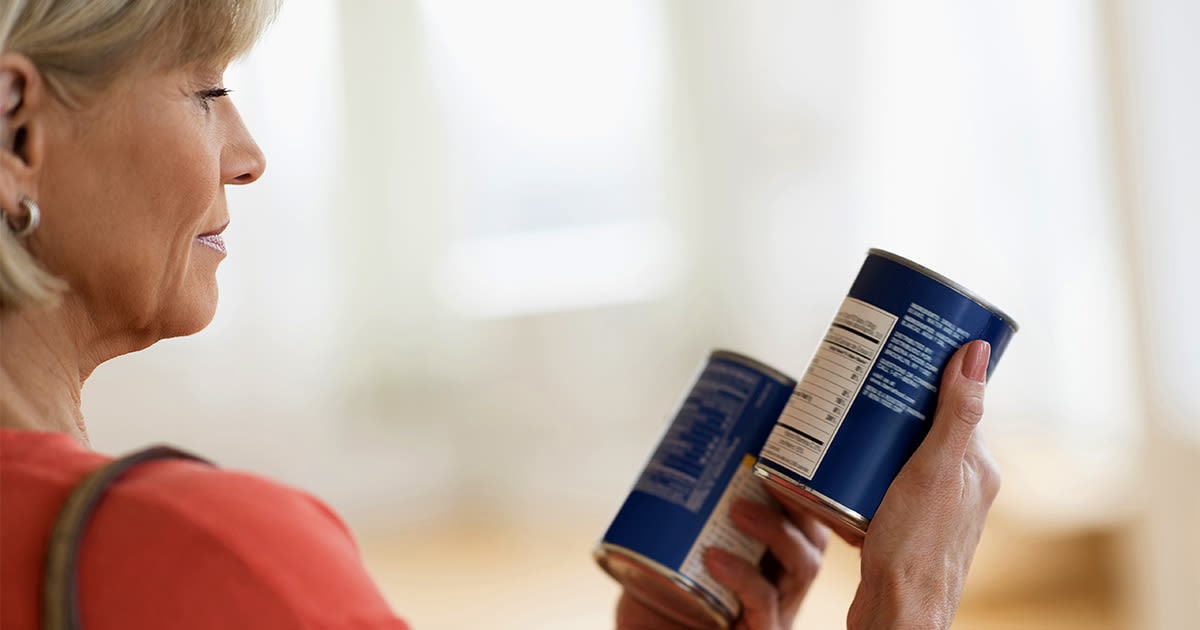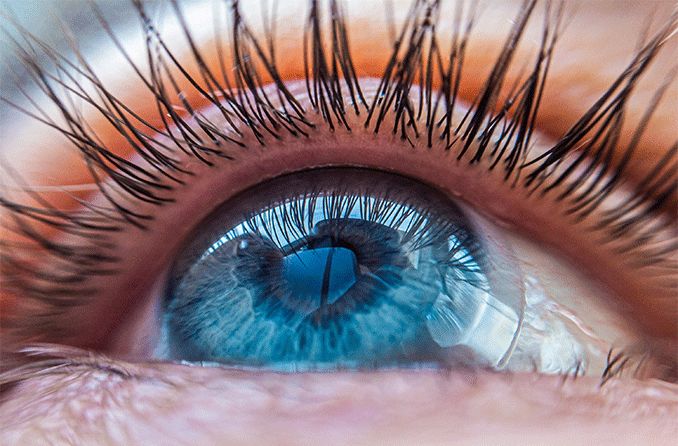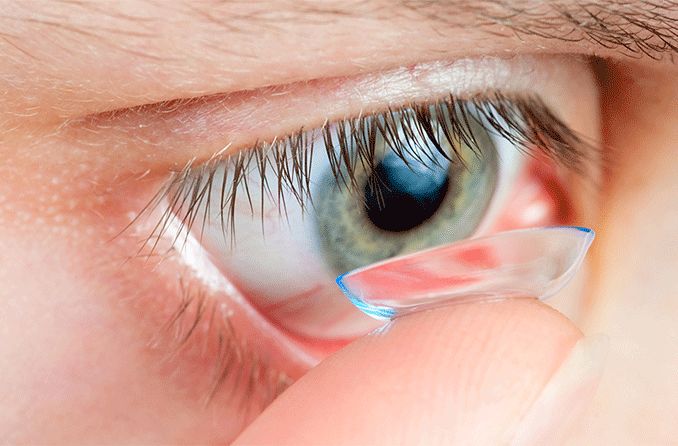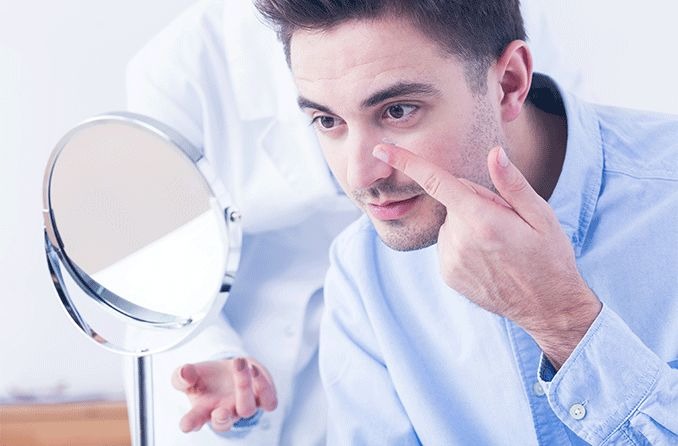What is a bandage contact lens?
A bandage contact lens — or therapeutic contact lens — is any contact lens used to relieve pain and help protect or heal the cornea and its nearby tissues. Patients usually wear them for a short time until their eye problem improves. However, they can be worn much longer for chronic eye conditions.
How does a bandage contact lens work?
The cornea requires certain conditions to be able to heal properly. It is also extremely sensitive to pain. A bandage contact lens works by creating a comfortable, safe and ideal environment for the cornea to heal.
Pain control
The cornea is the transparent membrane on the front of the eye. It has more pain receptors than anywhere else in the body. When it is scratched or damaged from a disease, infection, inflammation or surgery, these nerve endings are exposed. They can then be activated by air currents and the eyelid during a blink, resulting in severe discomfort. A bandage contact lens (BCL) covers the exposed nerve endings to help manage pain.
Healing
Healing of the corneal surface requires that epithelium cells move from the edge of the cornea to the damaged part. A BCL allows these cells to move smoothly to their destination without interference from blinks.
Protection
A BCL is a barrier that helps protect the cornea. It keeps the cornea from getting hurt by growths, bumps or foreign bodies on the inside of the eyelid, a misdirected eyelash, or anything else that can cause injury. It also keeps the eye from drying out when the eyelids are injured, are turned out (ectropion) or in (entropion), or do not close completely (lagophthalmos).
Some advanced treatments of the cornea, such as superglue repair of a thin cornea, a corneal lens implant (keratoprosthesis) or fitting a rigid gas permeable medical contact lens, require a BCL for best results.
BCLs can also help keep fluid from leaking out of the eye after cataract or glaucoma surgery or when a corneal ulcer causes a full-thickness break (perforation).
Drug delivery
A new use of BCLs is to supply medication to the eye. Soft contact lenses can be used to release drugs that were soaked into the lens material. In this way, BCLs may be used instead of having to regularly put eyedrops into the eye.
Types of bandage contact lenses
There are three main types of bandage contact lenses: soft, rigid gas permeable and hybrid. They are available in many materials, shapes and sizes to suit various needs. Eye doctors choose the best type of BCL for each patient based on their individual eye concerns.
Soft
Soft BCLs are selected based on what they will be used for. Most BCLs will stay in the eye overnight and will need to be breathable so that enough oxygen can reach the cornea while the eyes are closed. For other conditions treated with BCLs, it is more important that the lens does not break, fold up or move off the cornea. In these cases, sturdier BCLs are chosen that come in different shapes and sizes.
Many different types of soft contact lenses can be used as a BCL; however, only a few are officially approved by the Food and Drug Administration (FDA):
- Acuvue Oasys (Johnson & Johnson)
- Air Optix Night & Day Aqua (Alcon)
- Purevision (Bausch & Lomb)
- Sof-Form 55 EW (Unilens)
When a lens is used for a particular purpose that is not approved by the FDA, it is called “off-label use.” Off-label use of a contact lens is allowed and requires that the doctor use their medical experience to decide whether a contact lens can be used safely as a BCL.
A lens that is often used as a BCL but is not approved for this by the FDA is:
- Kontur (Kontur Kontact Lens Co.) – This lens comes in many shapes and sizes and can cover the conjunctiva as well as the cornea.
There is one soft contact lens approved to deliver medication to the surface of the eye:
- Acuvue Theravision (Johnson & Johnson) – This contact lens provides a steady supply of ketotifen — an allergy medication — to the eye.
Rigid gas permeable
Rigid gas permeable (RGP) contact lenses are made out of a breathable material that retains its shape even when placed on an irregular cornea. This allows RGP lenses to focus light accurately even when the cornea is scarred or damaged. RGPs are custom-designed by your eye doctor to accurately fit your eyes. RGPs come in two categories:
- Corneal lenses – This type of lens is smaller than the diameter of the cornea. They are easier to insert into the eye, can help improve vision for those with irregular corneas and protect the eye from drying out. Some disadvantages of this type of lens are that they fall out of the eye more easily and the edges can feel uncomfortable.
- Scleral lenses – This type of lens is larger than the diameter of the cornea, and the edges are designed to rest snugly on the sclera (the white part of the eye). These lenses are very stable on the eye and provide a much larger area of protection. Eyes damaged by severe dry eye benefit from a protective layer of fluid that is trapped behind this lens. These lenses can be hard to get into the eye and require special care. Scleral lenses are also custom-made for an individual eye. There is even a scleral lens called EyePrintPRO that is made from a custom mold to conform exactly to the shape of the eye.
Contact lens combinations
When an RGP lens is required for good vision but is uncomfortable or damages the cornea, there are options that combine a soft and RGP contact lens:
- Piggyback contact lenses – This is when an RGP lens is worn on top of a soft contact lens. While this may seem cumbersome at first, it is worth the extra time to handle and take care of two sets of lenses. The soft lens keeps the cornea comfortable and safe, while the RGP provides a rigid surface that focuses sharply.
- Hybrid lenses – SynergEyes company created an RGP blended to an edge made out of soft contact lens material called a “skirt.” This lens combines the benefits of an RGP lens (good vision, the ability to trap tears behind the lens) with the comfort and stability of a soft contact lens.
Eye conditions treated with bandage contact lenses
BCLs can help the cornea heal from many different types of eye conditions. They also help reduce the pain caused by corneal damage from disease and injury. In many cases, patients will also wear a bandage contact lens during recovery from an eye surgery.
Corneal abrasion
A scratch of the eye — also called an abrasion — is one of the most common problems treated with a BCL. Corneal abrasions are so painful that patients typically go straight to the urgent care clinic or emergency room. Unfortunately, these clinics generally do not have BCLs in stock, and treatment is usually an antibiotic ointment, pain medication and, sometimes, patching of the eye, none of which relieve pain and heal the eye as well as a BCL.
If possible, find a doctor that fits contact lenses and ask to be seen for an urgent add-on visit to have the eye evaluated and treated.
Recurrent corneal erosion
A recurrent corneal erosion (RCE) ordinarily occurs while waking up. It will feel like there is an eyelash in the eye or worse. RCEs heal within 24 hours, and the pain should slowly get better as the day goes on. Causes of RCEs include a history of corneal abrasion or corneal dystrophy. RCEs often keep occurring and can be treated with a BCL.
Corneal dystrophy
Corneal dystrophies are not present at birth and develop at some stage in life. The most common is map dot fingerprint corneal dystrophy. They can cause irregularity, scarring or recurrent erosions, all of which can be treated with different types of BCLs.
Dry eye and filamentary keratitis
A reduction in the production of tears or an unstable tear film often causes gritty, dry eyes and blurred vision. The lack of lubrication can cause tiny erosions on the surface of the eye that cause pain. In severe cases, small tags (called filamentary keratitis) form on the surface of the cornea that activate the pain receptors in the eye with every blink. A BCL will shield the eye and remove the corneal filaments.
READ MORE about corneal filaments and other types of keratitis
Neurotrophic keratitis
Neurotrophic keratitis (NK) is when the cornea loses its ability to sense pain, usually from damage to the trigeminal nerve (also called the fifth cranial nerve). Damage to this nerve affects the health of the surface of the cornea and leads to eroding, thinning and, in extreme cases, perforation (a break of all the corneal layers).
Photokeratitis
This painful condition is caused by exposure to intense ultraviolet light, such as from welding, tanning or bright sunlight. A BCL will protect the corneal nerve endings from being rubbed by the eyelids.
LEARN MORE about photokeratitis
Corneal ulcer and perforation
Infection, inflammation and surgery can result in the formation of an open sore of the cornea (a corneal ulcer), which can lead to a corneal break (perforation) and cause the contents of the eye to leak out. Tissue adhesives such as cyanoacrylate glue are used to seal and heal the perforation. A BCL will keep the eyelids from displacing the glue and is essential for healing.
Recovery from eye surgery
Refractive surgery such asPRK and procedures such as corneal crosslinking and cornea transplantation result in the removal of the epithelium on the surface of the eye. A BCL is required for the healing of the eye.
Complications from eye surgery
Glaucoma, cataract, refractive and other eye surgeries can result in complications:
- Bleb leak – Trabeculectomy — a type of glaucoma surgery — creates an incision in the sclera to allow fluid to leave the eye more easily. This fluid creates a small blister called a “bleb” that can leak, resulting in the pressure of the eye becoming too low (hypotony) or the contents of the eye developing an infection (endophthalmitis). A large-diameter BCL is required (such as the Kontur lens) that is big enough to cover the leaking area.
- Incision leak – Surgery to remove a cataract requires that small incisions are made in the cornea. These occasionally leak, causing dangerously low pressure or infection. The BCL will keep the eye pressure normal, reduce the risk of bacteria entering the eye and keep the eyelids from interfering with the healing of the incision wound.
- Bullous keratopathy – In some cases, eye surgery causes the cornea to become swollen, and small fluid pockets (called bullae) move to the surface. When bullae reach the surface, it results in a small erosion, causing pain. A BCL keeps the eyelids from rubbing on the erosions.
- Keratoprosthesis – Also called K-Pro, this is an artificial cornea consisting of a plastic lens embedded in a transplanted cornea. This surgery is done when a regular corneal transplant is not possible. The plastic lens sits above the surface of the cornea and can irritate the inside of the eyelid. The BCL provides comfort and reduces the chance that the cornea at the edge of the plastic lens becomes thin.
Eyelid disorders
The inside of the eyelids and the surface of the eye are extremely smooth to allow the eye to comfortably blink around a thousand times an hour. A loss of function, a wrong position or an irregular area on the inside or edge of the eyelid may require the use of a BCL.
The inside of the eyelid may develop an irregular area from:
- Scars – Surgery, infection or injury can cause a raised area.
- Styes and chalazia – Infected or blocked eyelid oil glands can form bumps or scars inside the eyelid.
- Concretions – Eyelid inflammation can cause small pieces of calcium deposits inside the eyelid.
- Foreign bodies – The most common foreign bodies found are dust, dirt, sand, cosmetics and displaced contact lenses.
The edge of the eyelid can develop new growths or irritations to the cornea:
- Benign lesions – These include a pimple on the edge of the eyelid (external hordeolum) or skin tag-type growths called papillomas.
- Malignant lesions – These include basal, sebaceous and squamous cell carcinoma and melanoma.
- Trichiasis – A misdirected eyelash can touch or poke the cornea.
- Distichiasis – The growth of a new eyelash from the opening of an eyelid oil gland can poke or scratch the cornea.
Problems with the function of the eyelid can include:
- Paralysis – Damage to the nerve that activates the eyelid muscles can make it impossible to close the eye (lagophthalmos).
- Surgery – An “eyelid tuck” (blepharoplasty) that results in too much tissue being removed or the removal of portions of the eyelid can leave the surface of the eye exposed.
- Coloboma – This is an inborn split in the upper or lower eyelid that can leave the eye exposed.
- Retraction and exophthalmos – Conditions such as Graves’ disease can cause the eyelids to pull away from the center of the eye and the eyelid to be pushed forward, making it hard or impossible to close the eye.
- Floppy eyelid syndrome – This softening of the eyelids makes it easy for the eyes to stay open during sleep and be scratched by the pillow.
- Entropion – The eyelid turns in, causing the eyelashes to scratch the surface.
- Ectropion – The eyelid turns out, causing the eye to dry out.
Proper care and handling
BCLs are usually placed on the eye and removed by the doctor. Follow the doctor’s instructions carefully. When the lens is worn overnight, an antibiotic eye drop is often prescribed to reduce the risk of infection. The use of artificial tears or rewetting drops that are approved for use with contact lenses is allowed. For most conditions, if the lens falls out of the eye, this is not an emergency and can be managed by returning to the eye clinic to have a new BCL placed on the eye.
In some cases — such as for dry eye management — the BCL will need to be removed at night and placed on the eye again in the morning. In this case, the clinic that initially fit you with your BCL should provide training on how to insert and remove the lens, as well as how to clean and take care of it.
Some do’s and don’ts of contact lens hygiene:
Do’s:
- Clean your hands before handling and cleaning the lenses.
- Use fresh contact lens solution every time you place the lenses in the case.
- Clean your contact lens case daily and replace it every two months.
Don’ts:
- Never “top off” your solutions in the case when storing your lenses at night.
- You shouldn’t bathe or swim with contact lenses in your eyes.
- Avoid sleeping in your lenses if you weren’t explicitly recommended to do so.
- Never use saliva or tap water to clean the lenses.
Side effects
Just like standard contact lenses, BCLs can lead to side effects or complications. This is especially true if they aren't used correctly. Some people may also be more sensitive to lens materials, solutions or wear. Always follow all of the doctor's instructions for wearing and cleaning your BCL.
Contact lenses can cause:
- Eye allergies
- Eye infections
- Corneal ulcers
- Corneal inflammation
- Corneal swelling
- Blood vessel growth in the cornea
Let your eye doctor know if you experience any symptoms of these side effects, such as:
- Blurred vision
- Eye pain
- Eye redness
- Discharge
- Teariness
- A change in the appearance of the eye (such as a white spot on the cornea)
The risk of a corneal ulcer goes up about fivefold when sleeping in lenses. The use of an antibiotic eye drop while wearing a BCL overnight should reduce the risk of ulcers.
When to see a doctor
A BCL is a medical device used to provide comfort and to heal and protect the eye. Since complications can arise, you should be seen regularly and follow your eye doctor’s instructions carefully to avoid complications from wearing a BCL.
